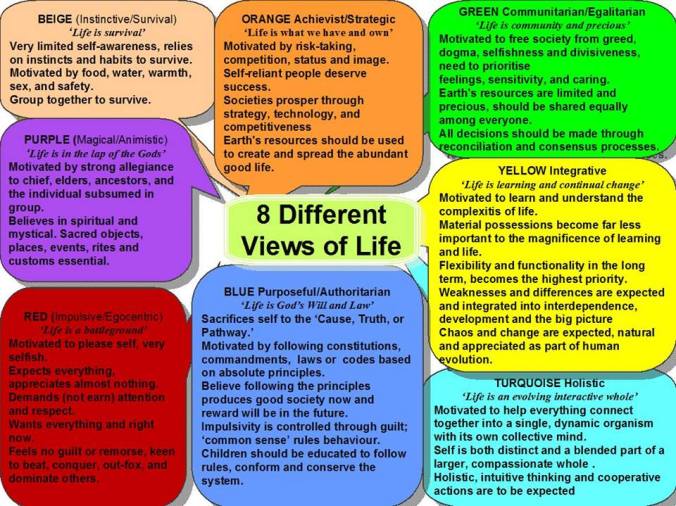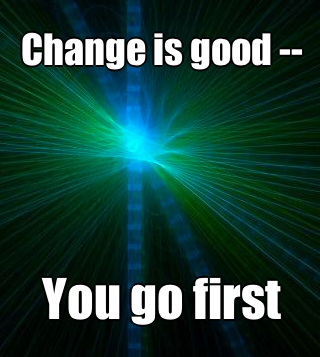“If one were to crystallize twentieth-century psychology into a single problem, it would be the problem of fear in the face of overwhelming evolutionary forces in humanity as a whole. At the end of the century we thought we were past that problem. We are now in the thick of it.”
~ John Campbell on Twitter
In Part 1 (LINK) and Part 2 (LINK) of this series, I have laid out some of the issues to be considered when planning and implementing programs designed to encourage greater diversity and inclusion in spiritual communities and other organizations. Using the Spiral Dynamics™ Model, one can see how different evolutionary values systems (vMEMEs) give meaning to terms such as “diversity,” “inclusion,” “racism,” and “white privilege.” Thee is also the issue of complexity of thinking at the different values systems. When we fail to see the presence of these values systems, we either make them wrong, present issues in highly complex ways, or ignore them entirely. This lack of “spiral awareness” means that many well-intentioned programs fail to be compassionate and to achieve the desired results.

The Values Systems (vMEMEs) of the Spiral Dynamics Model
It can be quite challenging from any point on the spiral to convey your values in such a way as they are understood by those centered at different levels. And, the “circular argument” (if you disagree with me/us it proves my/our point) is a sign that absolutism has entered the picture, which is unlikely to result in understanding or collaboration. While the concept of white privilege or straight while male privilege makes perfect sense to someone centered at the Green level of existence, it is very likely given a different meaning at other levels on the spiral. The result is that you think you are communicating one thing, but something else is being heard.
“Drawing a ‘privileged’ individual’s attention to the discrimination issue might be valuable (more awareness is better) but pushing them into the ‘perpetrator’ role (which personalized discussions of privilege do) rather than directly asking them to step up to help those disadvantaged is more likely to backfire and polarize potential allies than it is to solve the problem.”
~ Kylie Stedman
What is needed to ensure the highest level of success in programs intending to encourage greater diversity and inclusion, or to raise awareness of racism and sexism, include the following:
- Spiral Awareness – a recognition that different values systems exist so meaning making is not uniform.
- A focus on desired behaviors – rather than on labels which will be interpreted differently. For example: saying that “white privilege” is a given, for example, will not be received well by white people* who are not centered at the Green level of existence. Since they are the target audience for the program, alienating them means less likelihood of a successful program.
- Sharing stories – have representatives of all groups in the community share their stories, which may be of oppression or the ignorance of oppression. There is nothing more powerful than hearing from people you know and can relate to.
- Cast a Vision – programs including a sense of vision for what is possible are very powerful. This process can be participatory as well, thus growing a vision which is shared by as many participants as possible.
- Provide counseling – some people are going to need assistance to process strong feelings which will arise during programs such as this. Consideration should be given to how to best provide counseling to those who need it.
- Understand: Not Everyone Will Get It – it is important to realize that a person may be open, arrested, or closed at any level on the spiral. Some will not be willing to expand their sense of reality to include the values being presented. This is to be expected.

Cultural change requires time plus a deep understanding of the values systems present. It also requires an understanding of change itself; change is usually gradual with occasional leaps forward or setbacks, and often uneven. There needs to be proper support through the change process, especially for those with natural aversions to change (LINK) and for those for whom a particular change does not seem like a good idea.
Leadership has to be onboard with the change and has to model the desired behaviors in ways that everyone can see. Everyone’s value system must be acknowledged and approached in appropriate ways. This requires a lot from leaders and program managers, but the alternative is another program with little to no impact.
“An elemental law of psychology confirms that what is not faced in the developmental tasks of the parent will be visited upon the child. So it is true that what is not faced by corporate or collective leadership will be carried as a problem by the employees or members.”
~ James Hollis

As always, your comments are appreciated in the section below. Please consider following this blog if you are not already doing so (Click on the FOLLOW button), and feel free to share with your friends.
*People of Color centered in other values systems may understand white privilege differently than white people, however, they will still see it differently at each values system on the spiral.
Copyright 2018 – Jim Lockard
NOTE: I will soon be offering a two-part program in Spiral Dynamics™ for New Thought. Part one will be an introduction to the model; Part two, which is optional, will provide certification to teach and coach using Spiral Dynamics. More information soon.
Jim – any rough idea of when your spiral dynamics course will be offered?
LikeLiked by 1 person
It’s looking like early 2019 – probably will begin in February. Still some logistics to work out.
Thanks for asking!
Love and Light,
Jim
LikeLike
Yes, yes, YES on this post. In fact, I’ll go further. I sense there a dammed up backlog of desire for meaningful racial integration among segments at the blue and orange value systems–if only they were offered a level-appropriate path.
LikeLiked by 1 person
With the current emphasis on diversity it’s easy to overlook unity. That’s why I like “The Family Virtues Guide.” Its 50 virtues are common to all religious denominations regardless of their differences on values.
Written for children, it’s just as important for adults, perhaps even more so.
LikeLike